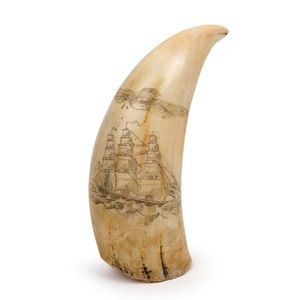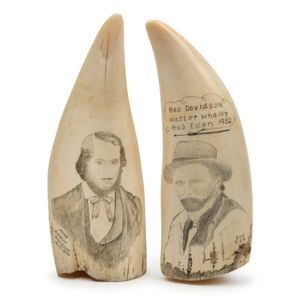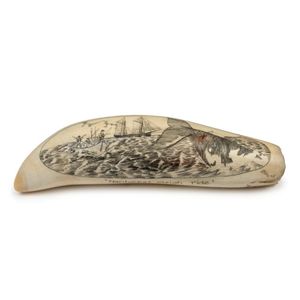
19th Century Scrimshaw Whales Teeth: Portrait of a Young Woman
A pair of 19th century scrimshaw whales teeth, each with an image of the same young woman wearing an off the shoulder dress, the fine scrimshaw work detailed in black and red ink. Heights 10 cm and 9.5 cm.

Sailor Portrait: Scrimshaw Whale Tooth, 11.5 cm High
A scrimshaw whale's tooth with naive portrait of a sailor, 11.5 cm high

Scrimshaw Whale's Tooth: Lady Shore, 1797 Engraved Tallship
A scrimshaw whale's tooth engraved with tallship titled 'Lady Shore, 1797', 13.5 cm long

Clipper Engraved Whale Tooth
A scrimshaw whale's tooth engraved with a tallship titled 'Clipper', 13 cm long

Tallship Scrimshaw: Whale Tooth Engraved with Two Views
A scrimshaw whale's tooth engraved with two views of a tallship, 15.5 cm long

Farming Scene Engraved on Scrimshaw Whale's Tooth, 16.5cm Long
A scrimshaw whale's tooth engraved with farming scene, 16.5 cm long

Tall Ship Scrimshaw Whale Tooth, 7cm - Nautical Decor
A scrimshaw whale's tooth with tallship decoration, 7 cm long

Whaling Scene and Tallship Scrimshaw Whale's Tooth
A scrimshaw whale's tooth depicting a whaling scene and tallship on reverse, 13.5 cm long

Whaling Scene Engraved on Scrimshaw Whale's Tooth, 13cm Long
A scrimshaw whale's tooth engraved with whaling scene, 13 cm long

Tallship Engraved Scrimshaw Whale Tooth with Floral Border
A scrimshaw whale's tooth engraved with tallship and floral border, 15 cm long

Scrimshaw Whale's Tooth: Engraved Female Portrait, Hand-Colored Finish
A scrimshaw whale's tooth with engraved female portrait with remains of hand coloured finish, 13 cm high

Scrimshaw Whale's Tooth: 'For Get Me Not' Tallship Portrait
A scrimshaw whale's tooth with tallship portrait engraved 'For Get Me Not' with knight engraved on the reverse, 16 cm high

Scrimshaw Whale's Teeth: Figural Engraved Pair, 11 cm High
A pair of scrimshaw whale's teeth with engraved figural decoration, 11 cm high

20th Century Whale Tooth Scrimshaw Collection
Three pieces of scrimshaw, 20th century, three substantial whale teeth, two with mid twentieth century engraving and colouring depicting tall ships and whaling scenes, one lightly engraved and inked, probably earlier, 16 cm long, largest tooth

Vintage Whale Tooth Scrimshaw: Galleon at Sea
An early whale tooth scrimshaw featuring galleon, height 13 cm

"H.M.S. Investigator - Capt. M. Flinders - 1802" scrimshaw tooth
A vintage scrimshaw whale's tooth titled 'H.M.S. Investigator - Capt. M. Flinders - 1802' by K. Neil, 20th century, 13 cm long

Vintage Scrimshaw Whale's Tooth: "Mistress of the Seas" Portrait
A vintage scrimshaw whale's tooth with tall ship portrait, engraved on reverse 'Mistress of the Seas', by James Cumberland brown of Albany, Western Australia, signed 'J. F. C.', 13 cm high

Scrimshaw Whale Tooth: Portrait of Young Boy
A scrimshaw whale's tooth engraved with a portrait of a young boy, 12 cm high

Scrimshaw Whale Tooth: Woman, Child, Urn, Floral Spray Engravings
A scrimshaw whale's tooth engraved with a woman and child, adorned with and urn and floral spray on the reverse, 13 cm high

Scrimshaw Whale's Tooth: Tallship, Eagle, Compass Engravings
A scrimshaw whale's tooth engraved with tallship below an American eagle, with compass point on the reverse, 12 cm high

Scrimshaw Whale Tooth: Tallship, Couple, Scottish Thistle Engravings
A scrimshaw whale's tooth engraved with tallship and romantic couple with Scottish thistle on the reverse, 12 cm high

The Sailor's Return: A Scrimshaw Whale's Tooth Engraving
A scrimshaw whale's tooth titled 'The sailor's Return', engraved with a tallship, sailor and American flag, 13 cm high

Romantic Scrimshaw Whale Tooth: Ship Portrait and Love Message
A scrimshaw whale's tooth with ship portrait and romantic scene verso, engraved 'Jane, My heart with Thee Will Stay When My ship sails Away', 13 cm high

Whale Tooth Scrimshaw: Woman and Ship Carving
A whale's tooth scrimshaw, carved with a woman's bust and a sailing ship. Length 21 cm.

19th Century Scrimshaw Whale Tooth: Women Under Tree
A 19th century scrimshaw whales tooth, the naive line drawn illustration depicting two women sitting beneath a tree, and the reverse with a small single figure of a woman, length 1 cm.

Whalebone and Ivory Treasures: Scrimshaw, Carvings, and Artifacts
Three whalebone cotton bobbins with scrimshaw decoration, whalebone busk carved with lizard decoration, Pacific Islander whalebone fishing hook, whale tooth toggle on keychain, antique Chinese carved ivory cigarette holder, marine ivory shoehorn and

Antique Ivory Scrimshaw Paperknife: Tallship and Sea Captain Vignettes
An antique ivory paperknife with scrimshaw vignettes of tallship and sea Captain, 19th/20th century, 31 cm long

Whalebone Carvings: Busk, Pocketknife, and Tooth with Engravings
A scrimshaw whalebone busk with engraved decoration, a whalebone pocketknife engraved with an apple and a whale's tooth carved with rose decoration, (3 items), the busk 15 cm long

Davidson Family Scrimshaw: Five Generations on Whale's Teeth Portrait
Eden Twofold bay interest: a fine pair of scrimshaw whale's teeth pertaining to the Davidson family showing five generations with portrait

Blackfish: Ready the Greenhand
Gary Tonkin (Albany, Western Australia) scrimshaw whale's tooth titled 'Blackfish, ready the Greenhand', signed 'G.R. Tonkin', 16 cm high

Twofold Bay Whaling Scene: Scrimshaw Whale's Tooth, 1828-1930
'Whaling in Twofold bay 1828-1930' scrimshaw whale's tooth depicting Eden's Twofold bay with whaling scene, signed 'Rene Davidson, Eden 13-12-2003', 18 cm high

Orca and Boyd Tower Scrimshaw Whale Tooth by Rene Davidson
'Old Tom and Friends' scrimshaw whale's tooth depicting the famous killer whale (orca) and the Boyd tower, signed 'Rene Davidson, Eden 17-7-2003', 12 cm high

Rottnest Lighthouse 1895: Scrimshaw Whale's Tooth by J. Cumberland
James Cumberland brown (Albany, Western Australia) scrimshaw whale's tooth titled 'Rottnest lighthouse built in 1895', signed 'J. F. C. Rms', 11 cm high

Splicing the Foreganger to the Harpoon
James Cumberland brown (Albany, Western Australia) scrimshaw whale's tooth titled 'Splicing the Foreganger to the Harpoon', signed 'J. F. C. Rms', 12.5 cm high

"Nantucket Sleigh Ride" Scrimshaw Whale's Tooth by J. F. C. Rms
James Cumberland brown (Albany, Western Australia) scrimshaw whale's tooth titled 'Nantucket sleigh Ride', signed 'J. F. C. Rms', 18.5 cm high

Scrimshaw Whale's Teeth: Patriotic Decorations from W. Kelly
A pair of scrimshaw whale's teeth with hand coloured decoration as well as British and American flags. One engraved 'Peace, Liberty, Unity' and the other 'I love Thee Still' with Queen Victoria sypher and signed on reverse 'W. Kelly'. (2 items). 15

Scrimshaw Whale Teeth: 19th Century Tall Ship Decorations
A pair of scrimshaw whale teeth, late 19th century, both decorated with tall ships, 13 cm high

Whaling Tragedy: Arctic Star Sinks in New Zealand Storm
Scrimshaw whale tooth, tall ship entitled 'Arctic Star' and 'Sank by a storm off the coast of New Zealand whilst engaged in whaling 1861' 10 cm length

Sperm Whale Tooth: Scrimshawed Beauty - 16cm Length
A sperm whale tooth with later scrimshaw, 16 cm length

Nouveau Nude: 20th Century Whale Tooth Scrimshaw, 11cm Height
An early 20th century whale tooth scrimshaw featuring Nouveau style nude, height 11 cm

"Maid of Erin" Whale Tooth Scrimshaw, 1856
An early whale tooth scrimshaw inscribed 'Maid of Erin. Sydney. 1856' featuring ship and possum to rear, length 14 cm

Minerva's Scrimshaw: Frigate and Wildlife on Whale Tooth
An early whale tooth 'Minerva. Port Jackson' scrimshaw featuring frigate and Australian wildlife, length 14 cm

Whale Tooth Scrimshaw: Good Condition with Natural Wear
A whale's tooth scrimshaw featuring boat length 8 cm condition - good - some general wear such as minor natural stress fractures, etc.

"The Flurry" Scrimshaw Whale's Tooth by Gary Tonkin
Gary Tonkin 'The Flurry' scrimshaw whale's tooth, Albany Western Australian, 11.5 cm long

Flinders' Tooth: Australia and Trim the Cat
A scrimshaw whale's tooth with portrait of Matthew Flinders and map of Australia titled 'New Holland New South Wales, 1804', with portrait of trim the cat on the reverse, 12.5 cm high

19th Century Scrimshaw Whale's Tooth with Tallship Portrait
A scrimshaw whale's tooth with tallship portrait, 19th century, an impressive 18 cm high

1840s Sailor Scrimshaw on Whale Tooth
An early Victorian scrimshaw, circa 1840s, the whale tooth lightly engraved and inked to one side with a full length image of a sailor, nice patina. Length 14.5 cm

Seascape Scrimshaw: Whale, Ship, and Sailors
Scrimshaw whales tooth, seascape scene with whale, ship, and sailors in a row boat. 14 cm length

Australian Scrimshaw Whale Tooth: "Dutch Galliot"
long800 Gary Tonkin Australian scrimshaw whales tooth titled 'Dutch Galliot', Albany, Western Australian origin, 20th century 14 cm long

1851 Scrimshaw Whale Tooth of Ship Runnymede and Whaling Scene
An impressive scrimshaw whale's tooth engraved 'Ship Runnymede of Hobart Town. Capt. James Bayley. 5 Month Voyage - 500 tuns sperm. 1851'. The reverse engraved with whaling scene with ship in the background. 17 cm long

Antique Scrimshaw Whale's Tooth with Slave Figures, 1830s
An antique scrimshaw whale's tooth engraved with two dancing African American slave figures, the reverse with courting couple scene, circa 1830s an impressive 18 cm high

Dragon and Vessel Scrimshaw Whale Tooth
A scrimshaw decorated whale tooth with a dragon and a vessel 15 cm

Scrimshaw Whale Tooth Container: Exquisite Carving
A scrimshaw whale tooth container., beautifully crafted and carved. Height 6 8 mm, width 16 cm, depth 6 cm

Scrimshaw Ship on Whale's Tooth
A mounted scrimshaw ship on whale's tooth, black and white scrimshaw on whale's tooth by Drake., Perfect for the desk of any maritime or scrimshaw collector. Height 15 cm, width 6.5 cm, depth 9 cm

Mother and Child Scrimshaw on Whale's Tooth
An antique whales tooth scrimshaw etched with mother and child, l15 cm

Engraved Charles W. Morgan Whales Tooth by G. Tonkin
Engraved scrimshaw whales tooth, The Charles. W. Morgan, signed G. Tonkin, 14 cm long

Scrimshaw Whale Tooth: Three Sailors at Work
Scrimshaw whales tooth, engraved with three bare foot saliors working the ropes, unsigned, 15.5 cm long

Scrimshaw Whales Tooth: Three-Mast Ship in Full Sail
Finely engraved scrimshaw whales tooth, of a three mast ship in full sail, 13.5 cm long

"Thermopylae" Engraved Whale Tooth Scrimshaw, Signed J.F.C
Engraved whales tooth scrimshaw, 'Thermopylae,' signed J.F.C, 15.5 cm long

Engraved Scrimshaw Whale Tooth by G. Tonkin
Finely engraved scrimshaw whales tooth, 'Ready the lance' signed G Tonkin, 13 cm long

Signed Scrimshaw Whale Tooth with Ship and Whaling Scene
An impressive scrimshaw whale's tooth engraved with ship portrait and whaling scene, signed on both sides (illegible), 13 cm long

Fijian Chieftain's Whale Tooth with Biblical Scene
Tabua scrimshaw whale's tooth, 19th century. An unusual combination of a Fijian chieftain's whale tooth pendant that has been souvenired by a sailor and decorated at some later point with biblical scene of Abraham to sacrifice Isaac. A rare example. 12 cm…

Cumberland's Tall Ship Scrimshaw
A scrimshaw example James Cumberland brown sperm whale scrimshaw. Depicting a tall ship. Length10 cm Length10 cm

Masonic Whale Tooth with Female Portrait
A scrimshaw whale's tooth with female portrait and Masonic iconography, 12 cm high

Antique Tasmanian Scrimshaw Whale's Teeth with Portraits
A pair of antique scrimshaw whale's teeth with engraved portraits, Tasmanian origin, 19th century, 10 cm and 10.5 cm high. Provenance: The Berry Collection, Young's Auctions, Melbourne, 2008

Whale Tooth Scrimshaw: 1877 Longboat Attack by C.S. Raleigh
A 20th century scrimshaw whales tooth signed 'C.S. Raleigh', finely incised decoration of a whale destroying a longboat. Inscribed with date 1877, length 13 cm

1698 Whale Tooth Scrimshaw with Historical Inscription
A whale tooth scrimshaw, length 11.5 cm inscribed with 'Weseltje, Nyptangh, Geelvinck, 1698, Willem de Vlaming, swan River' and signed 'Jespeh 1992 Albany',

Lizard Rib Scrimshaw on Stand
A heavily incised rib bone scrimshaw, height 43 cm, width 5 cm decorated with characters and tip bearing twin lizard like creatures, on metal stand,

Ebonised Scrimshaw Inkstand with Whale Teeth and Glass Bottle
A scrimshaw mounted ebonised inkstand, 19th century, with brass mounts and a cut glass ink bottle, the whale teeth each 10.5 cm long, 13 cm high, 30 cm wide, 20 cm deep

Main Sail Hoist
A scrimshaw whale's tooth titled 'Hoisting the Mainsail', signed 'J.F.C.', 20th century, 16 cm long

"Greasy Luck" Scrimshaw Whale Tooth with Tallship Scene
A scrimshaw whale's tooth titled 'Greasy Luck' with tallship scene, signed Tonkin, 20th century, 13 cm long

Tonkin's Whaling Scene
A scrimshaw whale's tooth titled 'Going On' with whaling scene, signed Tonkin, 20th century, 14.5 cm long

Tonkin's 'Sound Fast' Scrimshaw Whale Tooth
A scrimshaw whale's tooth titled 'Sound Fast' with whaling scene, signed Tonkin, 20th century, 13.5 cm high

Tallship and Whaling Scene Scrimshaw Whale's Tooth
A scrimshaw whale's tooth with tallship and whaling scene, 13.5 cm high

Queensland Scrimshaw: Whale Tooth with Cockatoo and Portrait
A scrimshaw whale's tooth with palm cockatoo and female portrait on reverse, Queensland origin, 12 cm high

Tree Engraved Whale Tooth: A Scrimshaw Masterpiece
A scrimshaw whale's tooth engraved with a tree, 10 cm high

Scrimshaw Whale Tooth: Deer Hunting Scene - 19cm High
A scrimshaw whale's tooth with deer hunting scene, an impressive 19 cm high

Whale Tooth Scrimshaw: Ship, Animals, and Love
19th century scrimshaw whale tooth, decorated with a sailing ship, anchors and love heart, lion and horse and the name William Smith to one side, and his initials, a lady holding a flower, kangaroo and ostrich to the other

Whale Tooth Scrimshaw & Miniature Replica of Sailing Ship
Early decorated whale's tooth scrimshaw with etched sailing ship decoration, length 14 cm together with a miniature replica scrimshaw, marked 'The Bark Cavalier, of New Bedford, Capt Nickerson,' length 7 cm

Antique Scrimshaw: Sperm Whale Tooth with Inscribed Decoration
Early sperm whale tooth scrimshaw with inscribed decoration, width 14.5 cm.

Kiwi Inscribed on Early Sperm Whale Tooth Scrimshaw
Early sperm whale tooth scrimshaw decorated with a inscribed kiwi, width 17 cm.

Encounter Bay Whaling Stations on Sperm Whale Tooth
A scrimshaw sperm whale tooth depicting South Australia's whaling stations, Encounter Bay area. Length 13 cm

19th Century North American Whalebone Toggle with Scrimshaw Decoration
A rare scrimshaw whalebone toggle decorated with deer and floral motif, monogrammed 'A. S', North American, 19th century, 3 cm high

Naval Scene Whalebone Brush, 19th Century
A scrimshaw whalebone brush with naval scene, 19th century, 16.5 cm across

Whaling Scenes on Scrimshaw Whale's Tooth
A scrimshaw whale's tooth with whaling scenes, 12.5 cm high

19th Century Scrimshaw Whale's Teeth with British Tallships
A pair of scrimshaw whale's teeth engraved with British tallships, 19th century, 14.5 cm high

Scrimshaw Whale Tooth with Whaling Scene and American Eagle
A scrimshaw whale's tooth with whaling scene, the reverse with American eagle, 17.5 cm high

Tallship and Sailor: Scrimshaw Whale's Tooth
A scrimshaw whale's tooth with tallship and sailor portrait, 13 cm high

19th Century Female Portrait Scrimshaw Whale Tooth
A scrimshaw whale's tooth engraved with a female portrait, 19th century, 13 cm high

Fern and Rose Scrimshaw Whale Tooth Portrait
A scrimshaw whale's tooth finely carved with female portrait surrounded by ferns and roses with rope carved border, 19th century, 14 cm high

Scrimshaw Whale Tooth: Engraved Female Figure in Hat
A scrimshaw whale's tooth engraved with a female figure in a hat, 13 cm high

Scrimshaw Whale's Teeth Engraved with Birds
Two scrimshaw whale's teeth engraved with birds, the smaller tooth engraved with a seagull and inscribed 'Favlt/Qvet', the larger tooth engraved with a stork, inscribed to verso 'Flamant', the largest tooth 10 cm long

Scrimshaw Whale Tooth with Turtle and Inscription
A scrimshaw whale's tooth engraved with a turtle, incised 'Tortve/Nicote' to verso, 11.5 cm long



 Loading more...
Loading more...